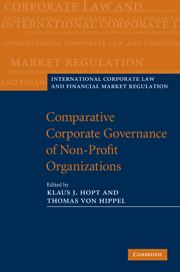Book contents
- Frontmatter
- Contents
- List of contributors
- Preface
- Abbreviations
- PART I Economic findings and theories on nonprofit organizations
- PART II The nonprofit sector: private law, trust law, tax law in selected countries
- PART III The board of nonprofit organizations
- PART IV Good governance of nonprofit organizations: activities and regulatory problems
- 10 Fundraising
- 11 Asset management in nonprofit organizations
- 11.1 Asset management in nonprofit organizations
- 11.2 Legal standards for capital investments by foundations in hedge funds according to German and American law
- 12 Nonprofit organizations and economic activities/enterprises
- PART V Good governance of nonprofit organizations: self-regulation, disclosure and supervision
- Index
- References
11.1 - Asset management in nonprofit organizations
from 11 - Asset management in nonprofit organizations
Published online by Cambridge University Press: 05 August 2011
- Frontmatter
- Contents
- List of contributors
- Preface
- Abbreviations
- PART I Economic findings and theories on nonprofit organizations
- PART II The nonprofit sector: private law, trust law, tax law in selected countries
- PART III The board of nonprofit organizations
- PART IV Good governance of nonprofit organizations: activities and regulatory problems
- 10 Fundraising
- 11 Asset management in nonprofit organizations
- 11.1 Asset management in nonprofit organizations
- 11.2 Legal standards for capital investments by foundations in hedge funds according to German and American law
- 12 Nonprofit organizations and economic activities/enterprises
- PART V Good governance of nonprofit organizations: self-regulation, disclosure and supervision
- Index
- References
Summary
Introduction
The issue of asset management in nonprofit organizations (NPOs) implies that the organization owns assets at all. This, to start with, leads to the different legal forms an NPO may obtain under German law: it can be an association, a nonprofit corporation, or a foundation.
Under civil law an association must not necessarily have assets at all; the nonprofit corporation is required to own a small minimum capital only; whereas the prototype of the foundation in this context may be defined as legally personified private capital or an independent amount of capital. The activities of the association are focussed on the activities of its members; those of the nonprofit corporation on the activities of its management; whereas the activities of the foundation are incorporated in the distribution of the proceeds of its capital.
On the other hand, all NPOs must follow the relevant provisions of the tax law in order to preserve their tax-exempt status.
Asset management, of course, represents only one sector of the NPO's target setting. For instance, considering the foundation, we do not look at the fulfilment of its statutory purpose in terms of quality – its optimum to be achieved – but exclusively at the process of generating proceeds of its capital representing the economic basis for this fulfilment. Consequently, the discussion of NPO asset management leads to economic, civil law and tax law aspects.
- Type
- Chapter
- Information
- Comparative Corporate Governance of Non-Profit Organizations , pp. 699 - 708Publisher: Cambridge University PressPrint publication year: 2010



